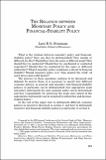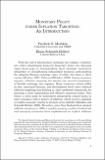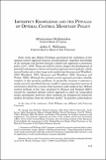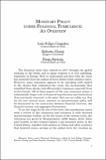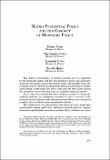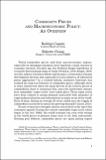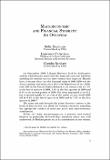Search
Now showing items 1-10 of 518
The relation between monetary policy and financial-stability policy
What is the relation between monetary policy and financialstability policy? How can they be distinguished? How similar or different are they? Should they have the same or different goals? How should they be conducted? Should they be coordinated or conducted separately? Should they be conducted by the ...
The fiscal footprint of macroprudential policy
, and this creates seignorage revenues. Inflation unexpectedly rises and this lowers the real value of public debt. Rolling over this debt is cheaper as the price of newly issued debt rises. And finally, economic activity rises, so tax revenues increase and social...
Monetary policy under inflation targeting: an introduction
With the end of intermediate exchange rate regimes, countries are either abandoning domestic monetary policy (by choosing super-hard pegs or relinquishing their national currencies altogether) or strengthening independent monetary policymaking (by adopting floating exchange rates, of either the clean ...
Independence, credibility, and communication of central banking: an overview
. Whether during the Global Financial Crisis, through individual country slumps, or at the trough of the pandemic recession, independent central banks were typically part of the solution rather than part of the problem. Attacks on the independence of a...
Risks to central-bank independence
their power or remit. These include everything from enhanced financial regulation to quasi-fiscal policy to mitigating economic inequality. Some recent populist proposals appear to be based on the presumption that central banks can issue large quantities...
Imperfect knowledge and the pitfalls of optimal control monetary policy
Sixty years ago, Milton Friedman questioned the usefulness of the optimal control approach because of policymakers’ imperfect knowledge of the economy and favored instead a simple rule approach to monetary policy (1947, 1948). These are still live issues, despite the development of powerful techniques ...
Monetary policy under financial turbulence: an overview
The financial crisis that started in 2007 brought the global economy to the brink and in many respects it is still unfolding especially in Europe. How to understand and deal with the crisis has naturally been the subject of fierce debates that continue today. However some consensus appears to be ...
Macro-prudential policy and the conduct of monetary policy
The 'Great Contraction' in global economic activity triggered by the financial crisis and the extraordinary fiscal and monetary measures that public authorities had to undertake in order to put the economy back on track by putting public finances under heavy strains and leading to extremely low ...
Commodity prices and macroeconomic policy: and overview
World commodity prices and their macroeconomic impact especially on emerging economies have long been a main concern in economic research. Decades ago the Prebisch-Singer hypothesis of secularly deteriorating terms of trade (Prebisch 1950 Singer 1950) was the subject of intense debate and became a ...
Macroeconomic and financial stability: an overview
On September 2008 Lehman Brothers filed for bankruptcy and the world became aware that the financial crisis that had been unfolding for months was far more serious than expected. Months later it became clear that the financial crisis of 2008-2009 was the worst economic downturn since the Great Depression ...

